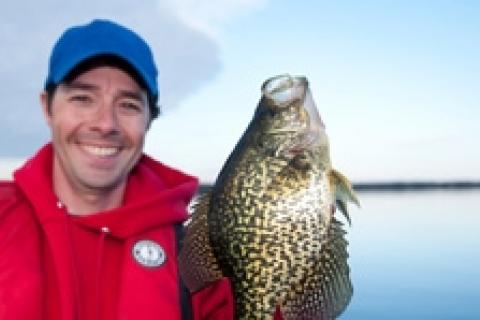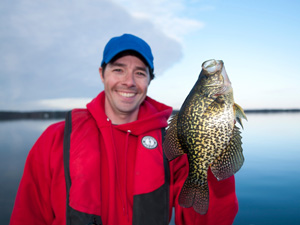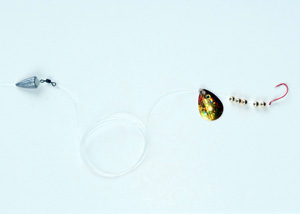
 Spring to autumn, panfish occupy a range of habitats from shallow weed flats to deep, rocky structures. Casting has merits, but there's plenty of trolling methods to pull panfish topside. Here are some popular strategies.
Spring to autumn, panfish occupy a range of habitats from shallow weed flats to deep, rocky structures. Casting has merits, but there's plenty of trolling methods to pull panfish topside. Here are some popular strategies.
Propulsion Picks
I most often use an electric motor for trolling. It's quiet, well-matched for following cover and structure contours, and delivers a lethargic pace when needed. Controlled wind-drifting and a small outboard are viable alternatives.
Trolling while paddling a canoe, kayak, or using a row-boat are other options. A simple watercraft and a light rod make for exciting fishing. Doing a starboard-to-port shuffle is common when battling a big, feisty panfish, in a breeze. This definitely increases the challenge when scrapping them form a small boat.
Fast Enough?
One mile-per-hour's a good average panfish trolling speed. Think close to double this figure when covering water or targeting big specimens. Conversely, dead-slow's frequently required to arouse fussy fish. Success relies on choosing an appropriate pace, which is species and mood dependent, and allows fish to attack accurately. Speed also influences lure action, so always check that a bait runs properly at boat side before letting out line.
Cranking 'Em Up
Hard-baits work in a variety of situations. Two to three inches is a good average size. Straight and jointed minnow-baits are excellent for skimming over cover for up-feeding panfish. Diving crankbaits, such as the Bass Pro Shops Crappie Maxx Crank, Strike King Slab-Hammer Crappie Crankbaits or a small Rapala Shad Rap, pulled through mid-depth areas will regularly fool panfish from rock bass to perch. In pothole lakes, trolling crankbaits beyond deep weed edges and along basin drop offs will take suspending crappie.
Whirling By Weeds
Plants provide refuge from predators along with forage for panfish. A spinner rig's streamlined properties make it a good choice for probing plants.
A common set-up includes a 1/4- to 1/8-ounce bullet weight on the mainline, followed by a bead for knot protection, a swivel, and then the spinner-clad leader. Pre-made spinners exist or you can tie your own using this recipe: a bead, a #2 to #4 Colorado blade and clevis, five beads, and a #4 to #8 snell or octopus hook assembled on a 30- to 48-inch lead of 6- to 8-pound test line. Sweeten the offering with a live or artificial chunk of nightcrawler, a leech, or a 2- to 3-inch minnow.
Tickling the top of vegetation or skimming a weed wall will catch all sorts of panfish. Be sure to occasionally weave away from outside weedlines as it's common for panfish to suspend out over deeper water adjacent to these plant partitions. Pulling a glow-bead model around weed edges and clumps, is a productive night strategy for crappie.
Working Jigs
 |
| A bullet sinker and worm spinner presentation. |
A jig and plastic combination is another viable trolling bait. Flat-lining's the basic approach for shallow water. Adding short twitches imparts a nervous scurry that'll trigger strikes. Soft-plastics, tied tinsel, and hair jigs will work but experiment to see if fish have a preference. For flash and added vibration use a bladed model, like the Uncle Buck's Panfish Creatures Minnows Rigged with Spinner Blade, the Northland Fishing Tackle Mimic Minnow Spinnerbait or the Road Runner Curly Tail. Trolling speed and lure weight influences running depth, so carry assorted jig weights.
Floating Around
Presenting a jig beneath a float is a good slow-trolling option. On a recent outing it proved the best way to take crappie suspended high in the water around standing timber. Keeping a wide berth, I'd motor to the wood's mid-way mark, lob out a cast to the target, and then troll it back into the strike zone. The float was helpful as its mass increased casting distance and accuracy, served as a reference point to position the jig, and signaled bites.
A variation on these rig is to replace the jig with a small bladebait, like the Bass Pro Shops XPS Lazer Blade. This lure has a knack for piquing the interest of big panfish, so be sure to give it a try this season.
Touring Bottom
In summer and autumn deep structures, like bars and humps, are hotspots for big panfish. A bottom bouncer or a three-way rig dangling a bell sinker both work to plunge a bait to bottom while trolling. Run a small two- to four-inch minnowbait, spinner rig, plastic on an Aberdeen hook, or wet fly behind these sinkers on a 30- and 48-inch fluorocarbon or monofilament leader.
Two's Better Than One
Another common strategy for trolling deeper fish, whether suspended or near bottom, is using two jigs. Separate jigs cover more of the water column but also allow experimentation to determine if panfish prefer a particular profile or color. To assemble it, tie the lighter jig of the two to 18- to 24-inches of 6-pound mono on the middle eyelet of a three-way swivel. Attach 30- to 38-inches to the bottom eye, followed by a heavier jig to avoid tangles.
A further variation is adding a split shot or an egg sinker (kept in pace by a swivel) half way down the bottom lead. This allows two lightweight jigs to be trolled. The extra weight keeps the presentation vertical in deeper water and permits faster trolling. Check fishing regulations for hook-per-line restrictions before using these rigs.
Map It Out
Regardless of presentation, plot a trolling route, ideally in a GPS unit, before wetting a bait. A designated path allows precision trolling around fish-holding sweet spots, helps avoid hazards, and prevent hang-ups. Use polarized sunglasses to locate healthy weeds and their contours in shallow water. Map charts, like those by Navionics, provide contour data for trolling deep structures. Fun also lies is the adventure of exploration, a lesson emphasized this past season on an unchartered lake with regular panfish pals, Rob Jackson and Phil Stinson.
While the three of us were debating our next move, stomach's grumbling under the mid-day sun, Phil says, "Let's throw out jigs and troll some new water while having lunch. I've discovered some great panfish spots this way."
Eyes glued to the sonar we probed mid-depth areas, with rod in one hand and a sandwich in the other. Before the crumbs disappeared from the communal bag of Doritos, we had found a panfish-loaded hump that kept us entertained for the remainder of the afternoon. Great advice, Phil.
- 7907 views

